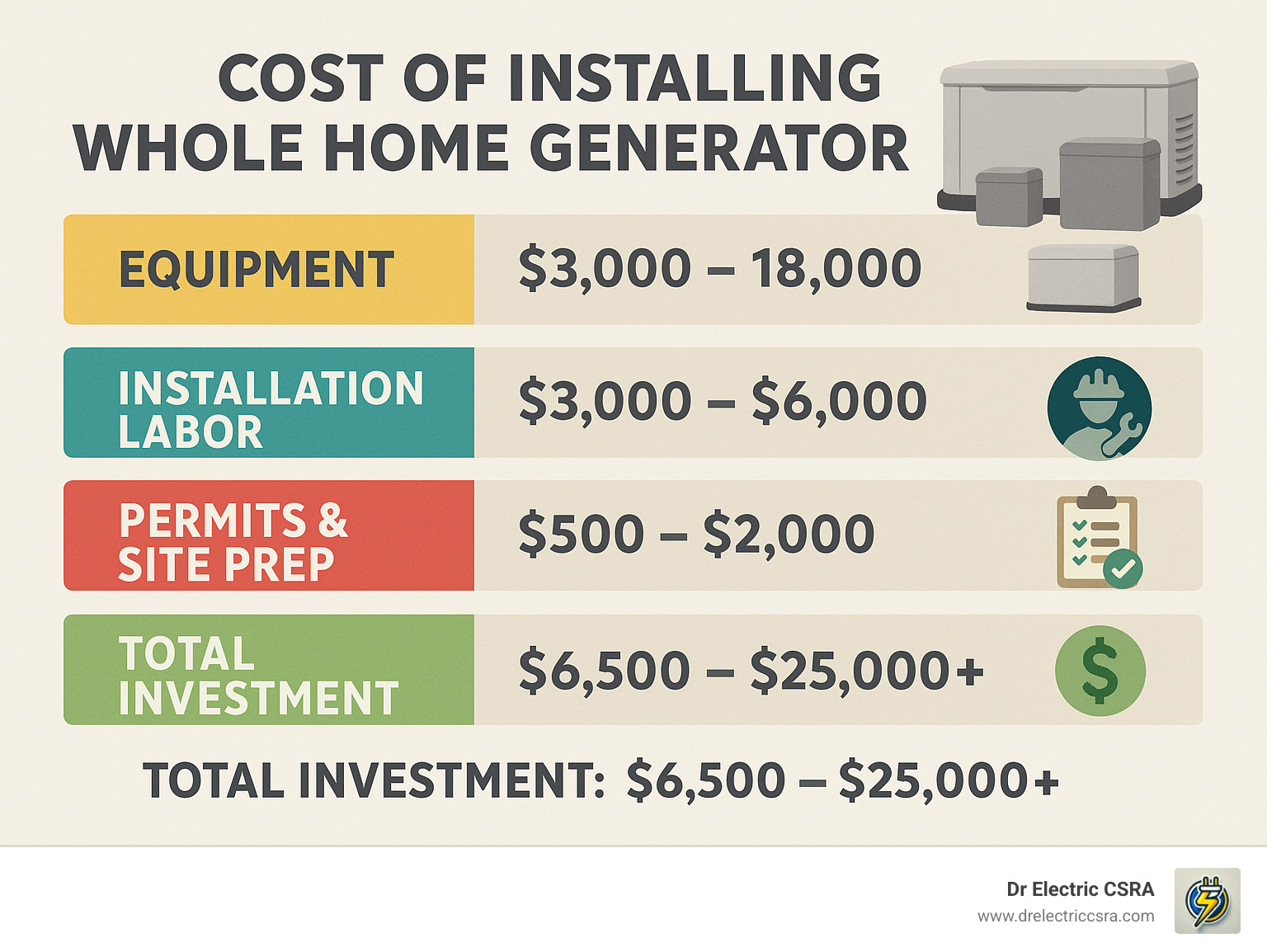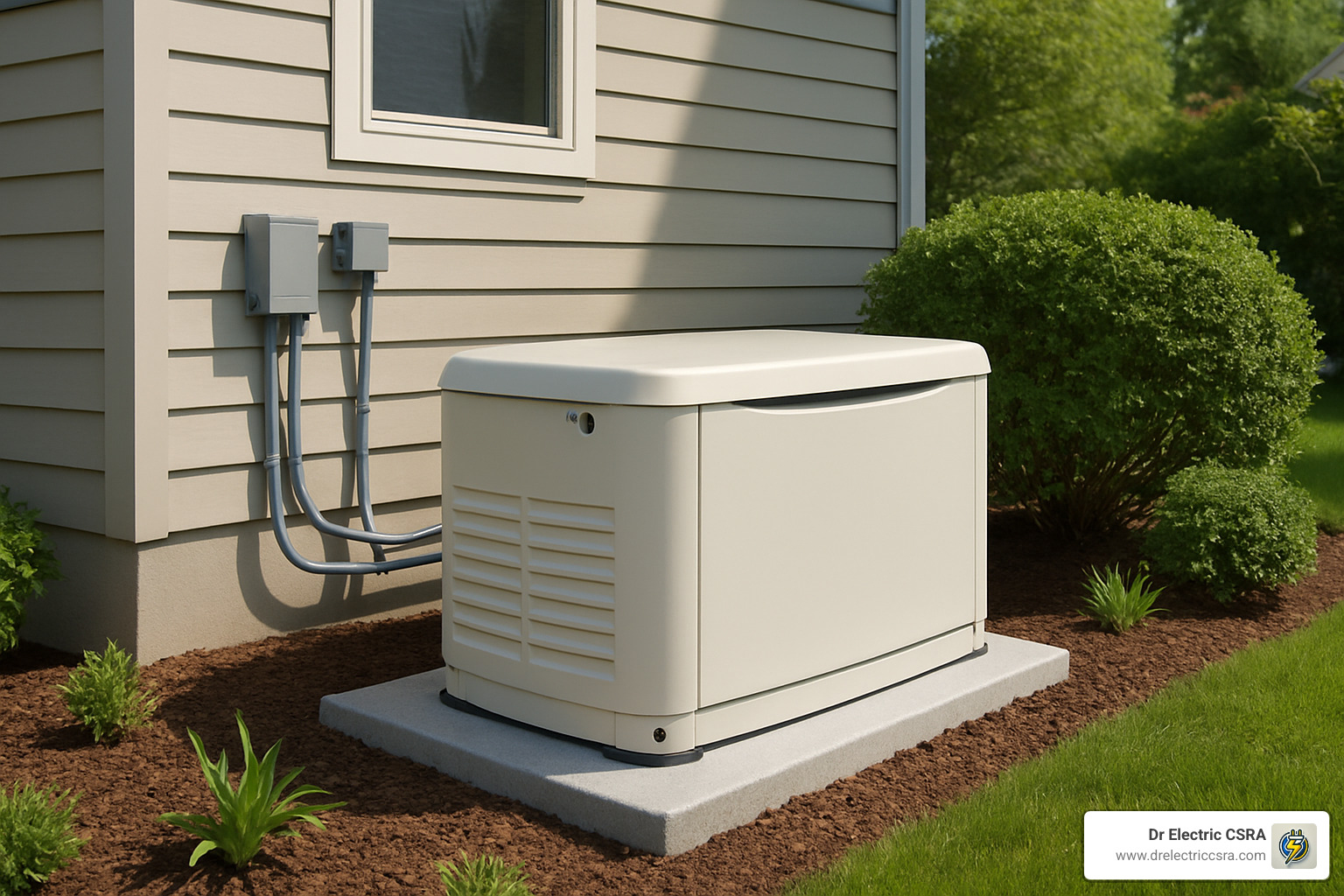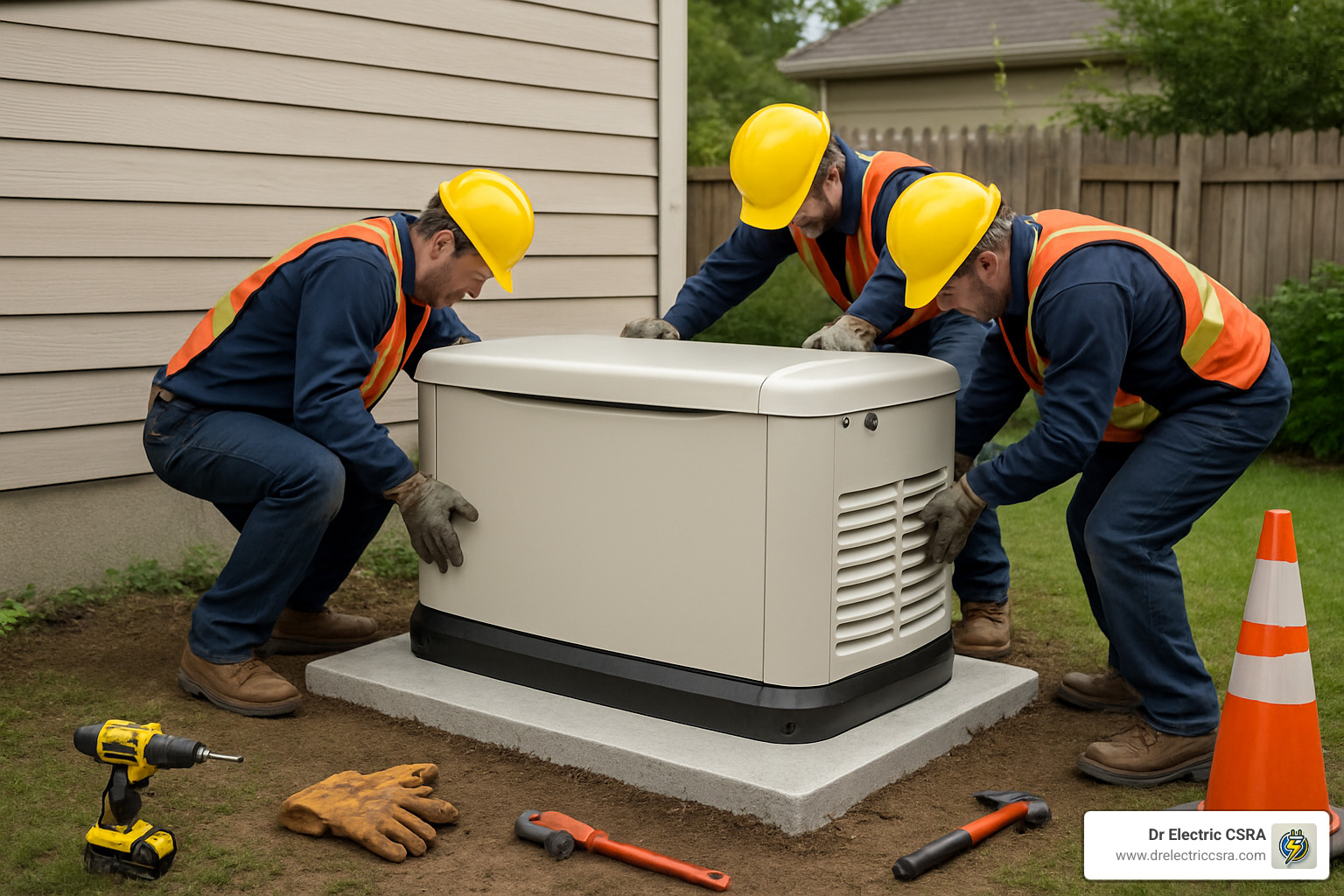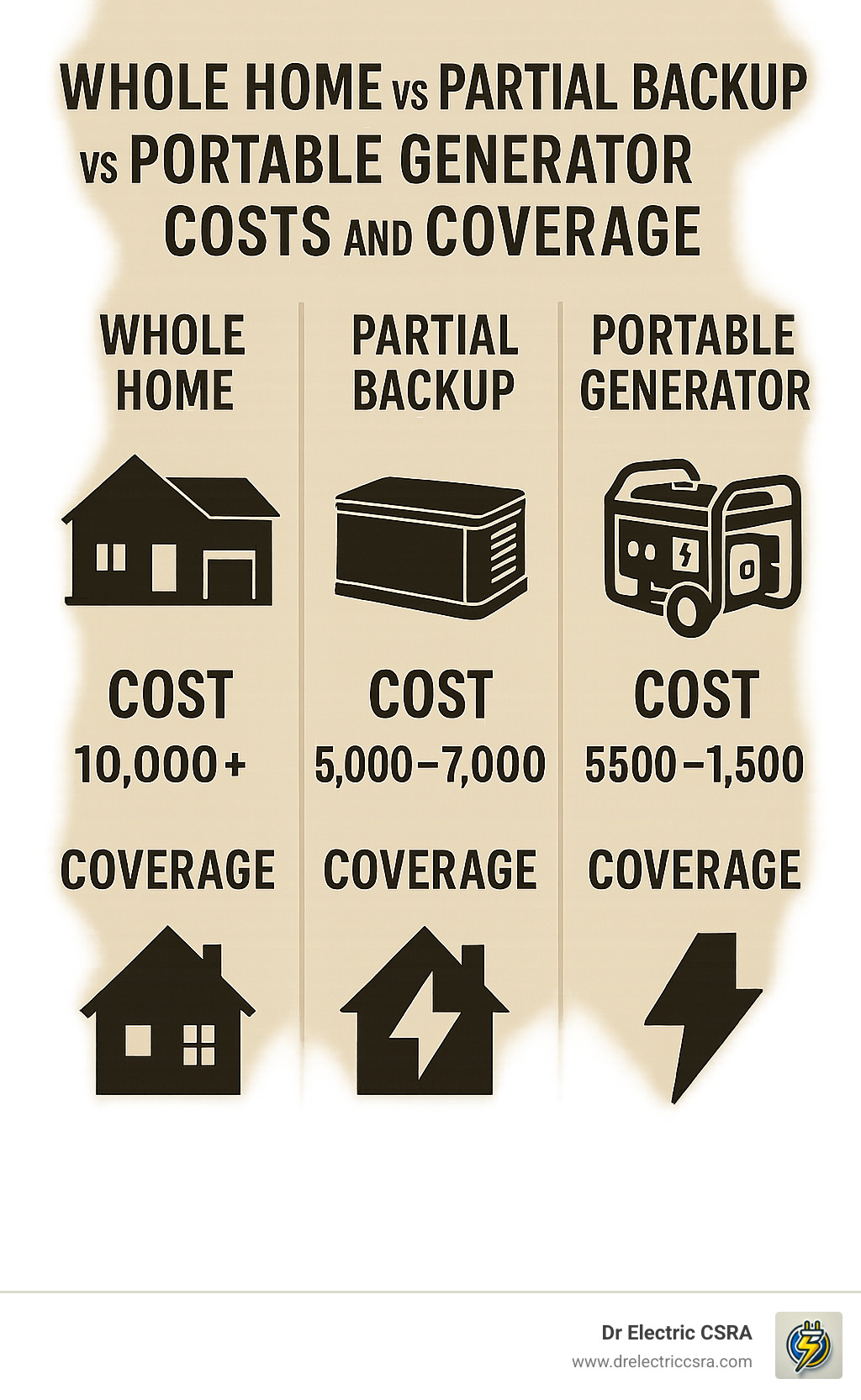Why Understanding Generator Installation Costs Matters for Augusta Homeowners
The cost of installing whole home generator systems typically ranges from $6,000 to $25,000, depending on your home’s size, generator capacity, and installation complexity. Here’s what you can expect:
Quick Cost Breakdown:
– Equipment: $3,000 – $18,000 (varies by kW size)
– Installation Labor: $3,000 – $6,000
– Permits & Site Prep: $500 – $2,000
– Total Investment: $6,500 – $25,000+ installed
When storms roll through the CSRA, power outages aren’t just inconvenient—they’re expensive. Spoiled food, lost productivity, and safety concerns add up fast. A whole home generator protects your family and property by automatically restoring power within seconds of an outage.
But here’s what many homeowners don’t realize: installation costs often surprise people. The generator unit itself is just part of the equation. You’ll also need electrical work, gas line connections, concrete pads, transfer switches, and permits.
As Jesse Burnett, Master Electrician and founder of Dr. Electric CSRA, I’ve installed dozens of backup generators across Augusta and the surrounding area, helping homeowners understand the true cost of installing whole home generator systems. My experience with over 1,200 electrical projects has shown me that proper planning and realistic budgeting lead to successful installations that provide decades of reliable backup power.

Quick cost of installing whole home generator definitions:
– Whole House Transfer Switch Installation Made Simple
– installing transfer switch for whole house generator
Understanding Whole Home Generators

A whole home generator, also called a standby generator, is a permanently installed backup power system that automatically kicks in when your utility power fails. Unlike portable generators that require manual setup and fuel storage, these units connect directly to your home’s electrical panel and fuel source.
According to scientific research on rising outages, weather-related power disruptions have increased significantly over the past decade, making backup power more critical than ever for homeowners in Georgia.
What Is a Whole Home Generator and How Does It Work?
At its core, a whole home generator operates like a car engine paired with an electrical alternator. The system includes sensors that continuously monitor your utility power. When these sensors detect an outage, the control panel automatically starts the engine-alternator combination within 10-20 seconds.
The automatic transfer switch is the brain of the operation. This device safely disconnects your home from the utility grid and connects it to generator power, preventing dangerous back-feeding that could harm utility workers. Once utility power returns, the system automatically switches back and shuts down the generator.
Choosing the Right Size for Your Home
Generator sizing depends on your home’s electrical load, measured in kilowatts (kW). Here’s what we typically recommend:
- 10-14 kW: Essential circuits only (lights, refrigerator, furnace, well pump)
- 17-20 kW: Mid-size homes up to 2,500 sq ft with one AC unit
- 22-24 kW: Larger homes up to 3,500 sq ft with multiple AC units
- 26+ kW: Large homes over 4,000 sq ft or homes with electric heat
We calculate your needs by adding up the running wattage of essential appliances plus the surge loads when motors start. Modern generators include smart load management that can cycle high-draw appliances to maximize efficiency.
The Cost of Installing Whole Home Generator – Complete Breakdown
Understanding the complete cost of installing whole home generator systems helps you budget accurately. After installing dozens of generators across Augusta, Evans, Grovetown, and Martinez, I’ve learned that homeowners often focus on the generator price alone—but that’s only part of the story.
The truth is, installation costs can surprise you. That $4,000 generator might become a $12,000 project once you add professional installation, permits, and site preparation. But here’s the good news: knowing what to expect helps you plan wisely and avoid sticker shock.
For detailed pricing information, check out our Whole House Generators Prices Installed guide.
| Generator Size | Equipment Cost | Labor & Installation | Total Installed Cost |
|---|---|---|---|
| 10-14 kW | $3,000 – $4,500 | $4,000 – $6,000 | $7,000 – $10,500 |
| 20 kW | $5,000 – $6,500 | $4,500 – $7,000 | $9,500 – $13,500 |
| 30+ kW | $8,000 – $15,000 | $5,500 – $8,500 | $13,500 – $23,500 |
Primary Equipment Costs and Typical Price Ranges for Different Sizes – cost of installing whole home generator
The generator unit itself represents about 60-70% of your total project cost. Think of it like buying a car—you’ve got economy models, mid-range options, and luxury versions.
Air-cooled generators are the workhorses of residential backup power. A 10-12 kW unit runs $3,000 to $4,500, while 14-18 kW models cost $4,000 to $5,500. The popular 20-24 kW size that handles most average homes ranges from $5,000 to $6,500.
Liquid-cooled generators are the luxury sedans of backup power. They run quieter and last longer, but your wallet feels the difference. A 26-32 kW liquid-cooled unit costs $6,500 to $15,000, while larger 36-38 kW models run $14,000 to $16,000. The big 45-48 kW units that power mansion-sized homes cost $16,200 to $21,000.
Brand reputation affects pricing too. Premium manufacturers command 10-20% more than economy options, but you’re paying for better engineering, longer warranties, and proven reliability during Georgia’s unpredictable weather.
Labor, Permitting, and Site Preparation – cost of installing whole home generator
Professional installation labor typically costs $3,000 to $6,000, and here’s where complexity really matters. A straightforward installation near your electrical panel and gas meter costs less than a complex setup requiring long wire and gas runs.
Electrical work represents the biggest chunk at $2,500 to $3,500. This includes Installing Transfer Switch for Whole House Generator, modifying your electrical panel, rewiring circuits, upgrading grounding systems, and ensuring everything meets current electrical codes.
Site preparation costs $500 to $1,500 and involves more than you might think. We pour a concrete pad at $50 to $75 per square foot, dig trenches for gas and electrical lines, and carefully position and level your generator. Poor site prep causes problems later, so we never cut corners here.
Gas piping runs $650 to $2,500, depending on distance from your meter. We install new gas lines, perform pressure testing and leak detection, and sometimes upgrade gas meters to handle the additional load. Distance matters—generators within 50 feet of utilities cost significantly less to connect than those requiring longer runs.
Permits and inspections typically cost $50 to $300. We handle electrical permits, gas line permits, and coordinate final inspections. Some homeowners try to skip permits to save money, but that’s penny-wise and pound-foolish. Proper permits protect you legally and ensure insurance coverage.
Accessories That Add Up
Optional accessories can add $500 to $2,000 to your project, but many provide real value. Cold-weather kits cost $200 to $400 and include battery and oil pan heaters—essential for reliable winter starting in Georgia’s occasional cold snaps.
Remote monitoring systems run $200 to $400 and send smartphone alerts about generator status, maintenance needs, and power outages. It’s peace of mind when you’re traveling or at work.
Smart load managers cost $300 to $600 and optimize power distribution by cycling high-draw appliances. They let smaller generators handle larger electrical loads more efficiently.
Sound enclosures range from $800 to $1,500 and significantly reduce noise—worth considering if you have close neighbors or local noise ordinances.
For homes needing electrical panel upgrades before generator installation, check our Upgrade Electrical services. Sometimes older panels need updating to safely handle transfer switch connections.
Installation Timeline, Process, and Professional Tips

Getting a whole home generator installed isn’t like buying an appliance at the store. It’s a custom electrical project that requires careful planning, skilled craftsmanship, and patience. After installing generators across Augusta, Evans, and surrounding areas, I’ve learned that homeowners who understand the process upfront have much smoother experiences.
The cost of installing whole home generator systems includes not just the equipment and labor, but also the time investment. Most homeowners are surprised to learn that while the actual installation work only takes a day or two, the complete project spans several weeks.
Step-by-Step Professional Installation Roadmap
Every successful generator installation starts with a thorough site survey. We visit your home to calculate electrical loads, measure distances to gas meters, and identify the best placement spot. This isn’t guesswork—proper site selection considers noise ordinances, utility setbacks, and drainage patterns.
The concrete pad comes next, and this step can’t be rushed. We pour a level, reinforced pad that’s sized for your specific generator model. The concrete needs 3-7 days to cure properly before we can place the generator. Trying to speed this up leads to cracked pads and equipment problems later.
While the concrete cures, we handle the transfer switch installation and electrical panel modifications. This involves carefully connecting your home’s electrical system to the new automatic transfer switch—the device that safely switches between utility and generator power. Our article on installing transfer switch for whole house generator explains this critical component in detail.
Gas line installation happens simultaneously with the electrical work. We run new gas piping from your meter to the generator location, pressure test everything, and coordinate with the gas company for final connections. Distance matters here—longer runs increase both time and cost.
The final testing phase is where everything comes together. We simulate power outages, verify automatic startup sequences, and make sure your generator seamlessly takes over when needed. Only after passing all tests do we schedule the final inspection.
How Long Does It Take?
Here’s the realistic timeline: 2-4 weeks from start to finish. The lead time for permits and equipment delivery often determines your start date, especially during peak storm season when everyone wants generators installed.
The actual on-site installation happens quickly once we begin. Our crew can typically complete the placement, wiring, and gas connections in 8-12 hours spread over 1-2 days. But between concrete curing, inspection scheduling, and weather delays, the total project timeline stretches longer.
Weather delays are real, especially in Georgia. We can’t pour concrete in freezing temperatures or work safely during thunderstorms. Starting your project during mild weather months helps avoid these delays.
Smart homeowners plan ahead. If you’re thinking about generator installation, don’t wait until the next storm warning hits the news. That’s when everyone calls, lead times stretch to months, and costs increase due to high demand.
Operating, Running & Maintenance Costs
Once you’ve covered the initial cost of installing whole home generator systems, it’s important to understand what you’ll spend to keep your backup power running smoothly. Think of it like owning a car—the purchase price is just the beginning.
The good news? Operating costs are more reasonable than most homeowners expect. According to scientific research on natural gas pricing, natural gas remains the most economical fuel choice for standby generators, which is why we recommend it for most Augusta-area homes.
Daily fuel costs vary significantly by what powers your generator. A 20 kW generator running continuously costs about $90 per day on natural gas, compared to $220 per day on propane or $175 per day on diesel. But here’s the reality check—most power outages last just a few hours, not entire days.
When Hurricane Helene knocked out power for 6 hours last year, homeowners with 20 kW natural gas generators spent roughly $22.50 in fuel costs. That’s less than a family dinner out, and their food stayed fresh while their neighbors lost hundreds of dollars in spoiled groceries.
Propane users pay more per day but gain fuel independence. Your propane tank won’t run dry during extended regional outages when natural gas infrastructure might struggle. Diesel generators offer excellent fuel efficiency but require more hands-on fuel management and storage.
Annual Maintenance and Service Contracts
Your generator needs regular care to start reliably when storms hit. We’ve seen too many generators fail during outages because owners skipped basic maintenance—don’t let that be you.
Professional service every 200 runtime hours or annually keeps your investment protected. This includes oil and filter changes, spark plug replacement, battery testing, and load testing to verify everything works perfectly. Liquid-cooled units also need coolant system service to prevent overheating.
Annual maintenance contracts run $200 to $650 per year, depending on your generator’s size and the service level you choose. Yes, it’s an ongoing expense, but it’s insurance for your insurance. A failed generator during a three-day outage costs far more than years of maintenance contracts.
We’ve rescued dozens of neglected generators over the years, and emergency repairs always cost more than preventive care. For any electrical issues that arise, our Electrical Repair services keep your entire electrical system running smoothly alongside your generator.
Generator Lifespan, ROI, and Home-Value Impact
Well-maintained generators last 15 to 30 years or up to 30,000 operating hours. That’s decades of reliable backup power from your initial investment. The key word here is “well-maintained”—generators that receive regular professional service consistently outlast those that don’t.
Your return on investment starts immediately. Every outage where your generator prevents $200 to $500 in spoiled food pays dividends. Add in maintained productivity for work-from-home situations, protected security systems, and prevention of frozen pipes during winter outages, and the value becomes clear.
Property value gets a nice boost too. Installing a whole home generator typically increases your home’s value by up to 5% and can provide up to 150% return on investment. Today’s buyers actively look for homes with backup power, especially in areas like the CSRA where storm-related outages are common.
The peace of mind factor is priceless, but the financial benefits make generators smart investments that pay for themselves over time.
Money-Saving Strategies & Alternatives

You don’t have to break the bank to get reliable backup power. Over my years installing generators across Augusta and the CSRA, I’ve finded several smart ways to reduce the cost of installing whole home generator systems without sacrificing the peace of mind you’re looking for.
The biggest money-saver? Partial home backup instead of powering absolutely everything. Think about it—do you really need to run the pool pump and electric dryer during a power outage? By focusing on essential circuits like your refrigerator, furnace, lights, and a few outlets, a 14 kW generator can handle what matters most for $3,000 to $5,000 less than a whole-home system.
Smart load management technology makes this even better. Modern generators are pretty clever—they automatically cycle high-draw appliances so you can run more with less. Your air conditioner might run for 20 minutes, then pause while the electric water heater kicks on, then switch back. You stay comfortable without needing a massive generator.
Timing matters more than you’d think. Installing during spring or early summer typically saves 10-15% because contractors aren’t swamped with storm-season emergencies. Nobody wants to think about generators when the weather’s nice, but that’s exactly when you’ll get the best deals and fastest service.
You can also tackle some site preparation yourself. Clearing brush, creating access paths, and basic yard prep doesn’t require an electrician’s expertise. Let us focus on the technical stuff while you handle the heavy lifting—literally.
For more details on transfer switch options, check out our guide: Whole House Transfer Switch Installation Made Simple.
Battery storage systems are becoming interesting alternatives too. While they cost more upfront, they’re silent, require no fuel, and work great for shorter outages. For longer outages or whole-home backup, generators still win on cost and capacity.
Common Pitfalls to Avoid
I’ve seen homeowners make expensive mistakes that could’ve been easily avoided. Under-sizing is the biggest one—buying a generator that can’t handle your actual needs defeats the whole purpose. That “great deal” on a 10 kW unit won’t seem so great when your furnace won’t start because there’s not enough power.
Skipping permits might save a couple hundred dollars now, but it creates headaches later. Insurance claims get denied, home sales get complicated, and you’re liable if something goes wrong. Trust me, the permit fees are worth it.
Poor placement causes problems too. Generators need proper clearances from windows, doors, and property lines. I’ve had to relocate units because homeowners didn’t realize their neighbor’s bedroom window was too close. Check local codes before choosing your spot.
Noise violations are more common than you’d expect. Some neighborhoods have strict noise ordinances, and generators can be loud. Air-cooled units especially can disturb neighbors if placed poorly. Consider sound enclosures or liquid-cooled units in noise-sensitive areas.
Choosing a Reputable Contractor
Your installer makes all the difference between a system that works flawlessly for decades and one that causes constant headaches. Look for licensed electricians with actual generator experience—not just general electrical work.
Insurance coverage protects you if something goes wrong during installation. Local references from recent jobs tell you more than any advertisement. A contractor who’s proud of their work will gladly share customer contacts.
Get written quotes that detail everything—no surprises later about “extra” costs for permits or site prep. Good contractors include comprehensive warranty coverage on both equipment and installation work.
At Dr. Electric CSRA, we’ve installed generators throughout Augusta, Evans, Grovetown, and Martinez. Our team is licensed, insured, and available 24/7 for emergency service. We understand that backup power isn’t just about convenience—it’s about protecting your family and home when storms hit.
Frequently Asked Questions about Whole-Home Generator Costs
After installing hundreds of generators across the CSRA, I get the same questions from homeowners almost every week. Let me share the answers that matter most when you’re planning your backup power investment.
How much does it cost per day to run a 20 kW natural gas generator?
Here’s the reality about operating costs: a 20 kW natural gas generator costs approximately $90 per day if it ran continuously for 24 hours. But here’s what that actually means for your wallet.
Most power outages last just a few hours, not entire days. During a typical 6-hour storm outage, you’ll spend about $22.50 in natural gas costs. Even during longer outages like ice storms that might last 12-18 hours, you’re looking at $45-70 in fuel costs.
I always tell my customers to think about it this way: that daily cost covers keeping your food fresh, your house comfortable, your security system running, and your family safe. Compare that to replacing a refrigerator full of groceries or dealing with frozen pipes, and the cost of installing whole home generator systems makes perfect sense.
Natural gas pricing fluctuates, but it remains the most economical fuel choice. Propane costs roughly 2.5 times more, while diesel falls somewhere in between.
How long does a whole home generator installation usually take from deposit to inspection sign-off?
The complete timeline from contract signing to final inspection typically spans 2-4 weeks. I know that sounds longer than many homeowners expect, but there’s good reason for each phase.
Week 1 focuses on planning and permits. We handle the paperwork while you wait, including electrical permits, gas line permits, and utility notifications. This behind-the-scenes work prevents delays later.
Week 2 involves site preparation, especially the concrete pad that needs 3-7 days to cure properly. We can’t rush concrete—it needs time to reach full strength to support your generator safely.
Week 3 brings the exciting part: actual installation. The physical installation takes just 8-12 hours with our crew, but we also complete final connections, testing, and inspections during this phase.
Weather can extend timelines, especially during concrete work or when storms delay inspections. We always communicate any delays immediately and work around Mother Nature’s schedule.
Does installing a generator really boost my property value?
Absolutely, and the numbers prove it. Whole home generators can increase your property value by up to 5% and often provide up to 150% return on investment. I’ve seen this when helping homeowners prepare for sales.
The real estate market has shifted dramatically over the past few years. Buyers increasingly prioritize homes with backup power, especially here in Georgia where storm-related outages are common. Your generator becomes a major selling point that sets your home apart.
But the value goes beyond just resale numbers. Think about the peace of mind and daily benefits: no more worrying about storms, no more throwing away spoiled food, no more disrupted work-from-home schedules. Many of my customers tell me the generator pays for itself through avoided hassles alone.
The investment often makes financial sense even if you never plan to sell. Between prevented food spoilage, avoided hotel stays during extended outages, and maintaining productivity during power failures, the cost of installing whole home generator systems justifies itself over time.
Real estate agents in our area consistently tell me that homes with generators sell faster and for higher prices than comparable homes without backup power. It’s become an expected feature rather than a luxury upgrade.
Conclusion
When the lights go out in Augusta, you’ll be glad you understood the real cost of installing whole home generator systems before making your decision. Yes, that $6,000 to $25,000 investment might seem significant upfront, but it’s really about protecting what matters most—your family’s comfort, safety, and peace of mind.
Think about it this way: you insure your car, your home, and your health. A whole home generator is insurance against power outages that can spoil hundreds of dollars in food, leave you without heat or air conditioning, and disrupt your daily life for days or even weeks.
Professional installation isn’t just recommended—it’s essential. The difference between a generator that works flawlessly for decades and one that fails when you need it most often comes down to proper installation. At Dr. Electric CSRA, we’ve seen too many DIY attempts that created safety hazards or simply didn’t work when storms hit.
Our experience with hundreds of installations across Augusta, Evans, Grovetown, and Martinez has taught us that budgeting wisely means thinking long-term. A properly sized and professionally installed generator should serve your family reliably for 15 to 30 years. That breaks down to just a few dollars per month for the ultimate peace of mind.
Your backup power investment deserves expert guidance. Every home is different, and cookie-cutter solutions rarely work best. We take time to understand your specific needs, explain your options clearly, and provide detailed cost estimates that won’t surprise you later.
Ready to stop worrying about the next power outage? Let’s talk about protecting your family with reliable backup power. Contact Dr. Electric CSRA for a comprehensive consultation where we’ll assess your home’s needs and walk you through your options.
For more info about our services, visit our website. Because when the storm clouds gather, you’ll sleep better knowing your family is protected by professional-grade backup power that’s ready when you need it most.






0 Comments